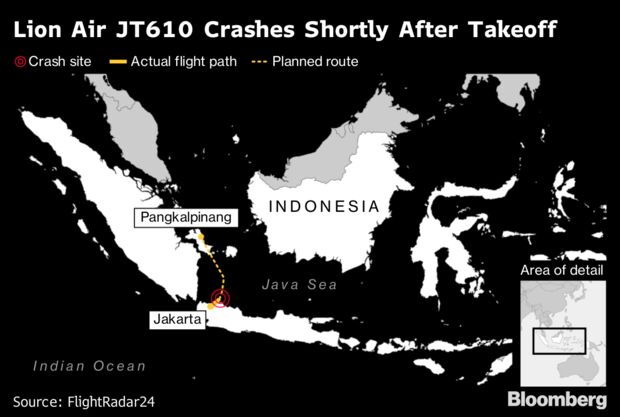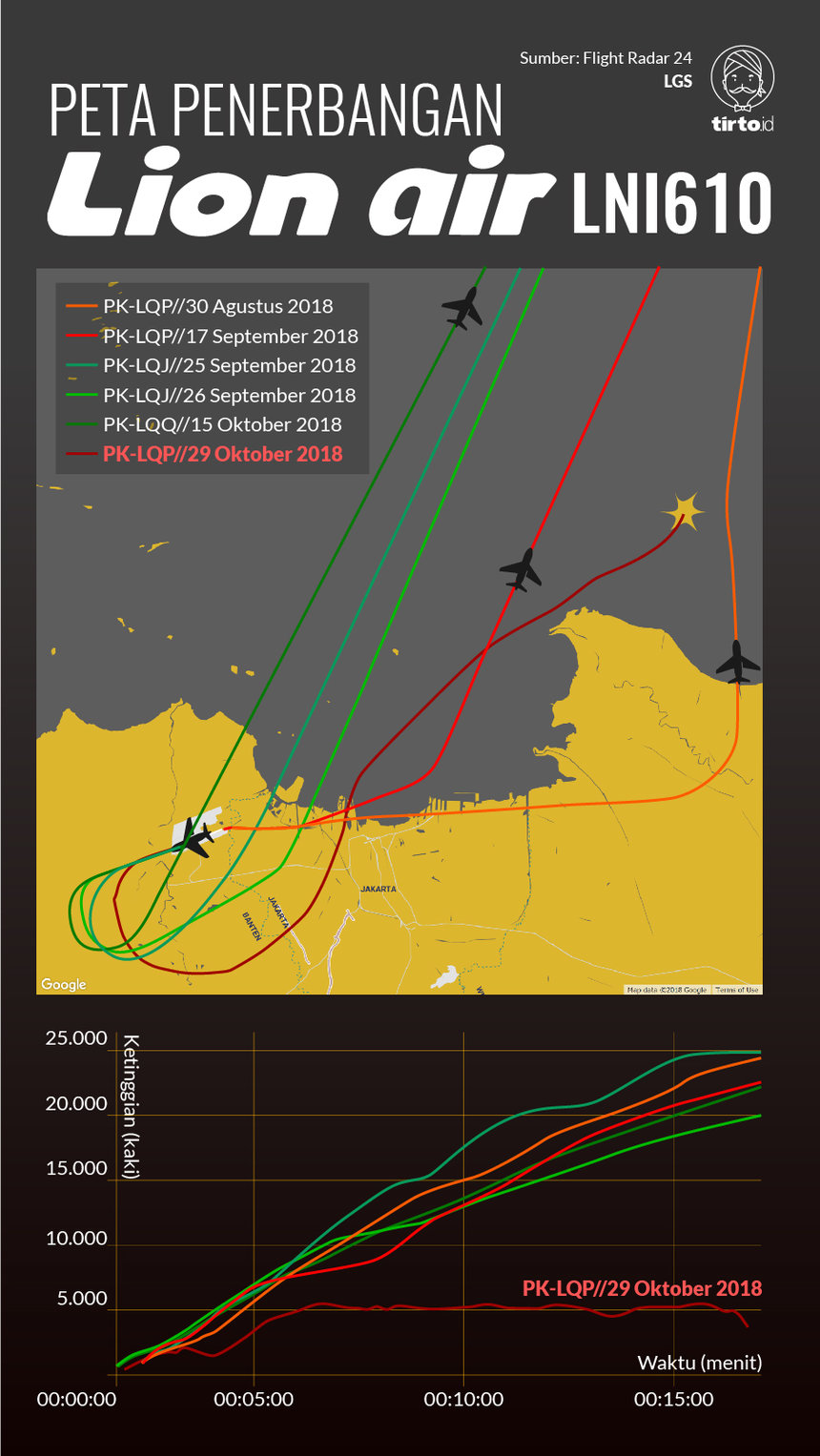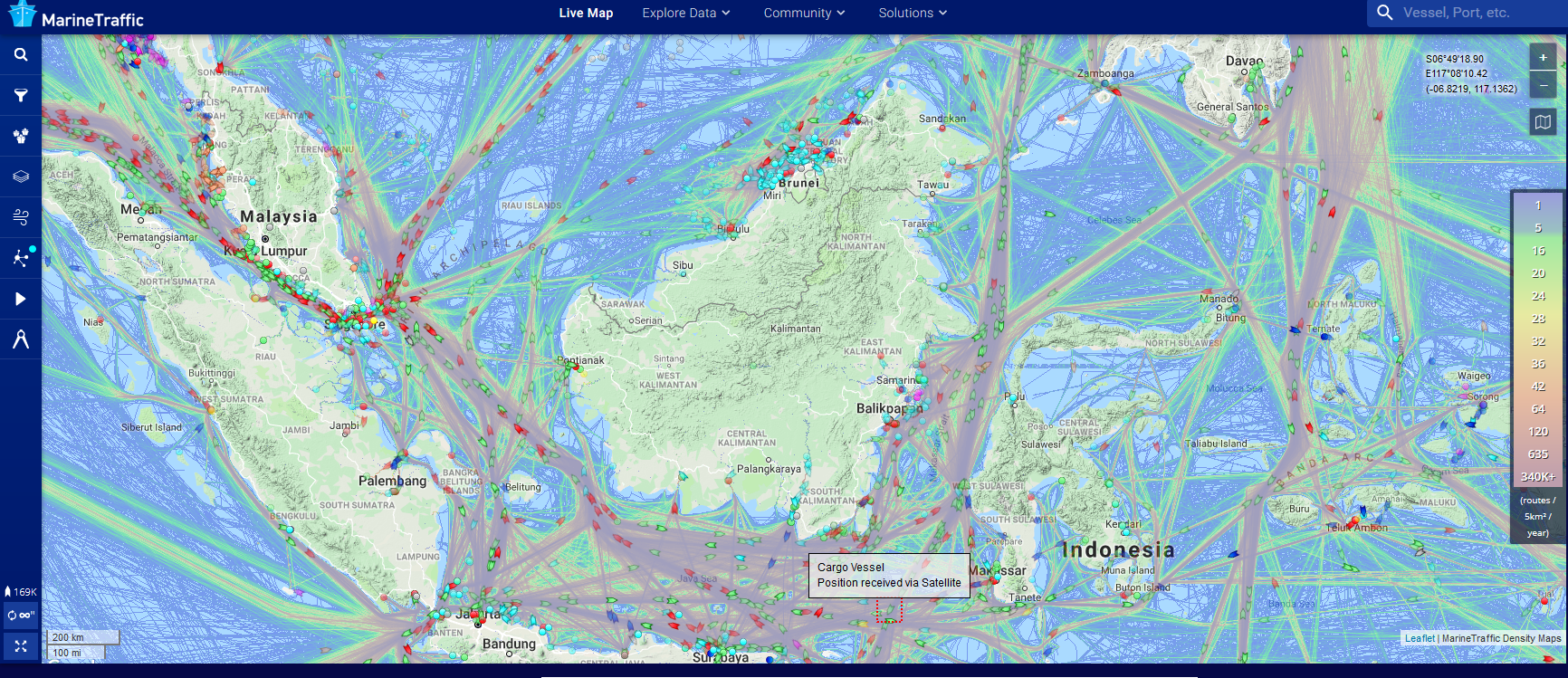angelburst29
The Living Force
KARAWANG, Indonesia (AP) -- A Lion Air plane carrying 189 people crashed into the sea just minutes after taking off from Indonesia's capital on Monday in a blow to the country's aviation safety record after the lifting of bans on its airlines by the European Union and U.S.
Mon. Oct. 29, 2018 - Indonesia Lion Air flight with 189 on board crashes into sea
Indonesia Lion Air flight with 189 on board crashes into sea
Indonesia's disaster agency posted photos online of a crushed smartphone, books, bags and parts of the aircraft fuselage that had been collected by search and rescue vessels.
President Joko Widodo ordered the transport safety commission to investigate and urged Indonesians to "keep on praying" as rescuers search for victims. A transport official said the flight requested to return shortly after takeoff from Jakarta. Weather conditions were normal but the brand new aircraft had experienced a technical issue on its previous flight.
Lion Air said the jet, on a 1 hour and 10 minute flight to Pangkal Pinang on an island chain off Sumatra, was carrying 181 passengers, including one child and two babies, and eight crew members.
Distraught friends and relatives prayed and hugged each other as they waited at Pangkal Pinang's airport and at a crisis center set up at Jakarta's airport. Indonesian TV broadcast pictures of a fuel slick and debris field in the ocean.
The National Search and Rescue Agency's deputy chief, Nugroho Budi Wiryanto, said about 300 people including soldiers, police and local fishermen were involved in the search and that so far it has recovered no bodies — only ID cards, personal belongings and aircraft debris.
"We are waiting for the miracle from God," said Wiryanto, when asked if there were any hope of survivors.
At the agency's headquarters in Jakarta, family members waited desperately for news.
Feni, who uses a single name, said her soon to be married sister was on the flight, planning to meet relatives in Pangkal Pinang.
"We are here to find any information about my younger sister, her fiance, her in-law to be and a friend of them," said Feni.
"We don't have any information," she said, as her father wiped tears from reddened eyes. "No one provided us with any information that we need. We're confused. We hope that our family is still alive."
Indonesian Finance Minister Sri Mulyani also arrived at the agency and met with its chief, seeking information about 20 ministry staff who were on the flight after attending a ministry event in Jakarta.
The search and rescue agency said the flight ended in waters off West Java that are 30 to 35 meters (98 to 115 feet) deep.
The agency's chief, Muhammad Syaugi, told a news conference that divers are trying to locate the wreckage.
Weather conditions for the flight were safe, according to the Indonesian meteorology agency. It said the type of clouds associated with turbulence was not present and winds were weak.
The Boeing 737 Max 8 was delivered to Lion Air in mid-August and put in use within days, according to aviation website Flightradar24. Malindo Air, a Malaysian subsidiary of Jakarta-based Lion Air, was the first airline to being using the 737 Max 8 last year. The Max 8 replaced the similar 800 in the Chicago-based plane maker's product line.
Lion Air president-director Edward Sirait said the plane had a "technical problem" on its previous flight from Bali to Jakarta but it had been fully remedied. He didn't know specifics of the problem when asked in a TV interview. The pilot of Flight 610 had more than 6,000 flying hours while the co-pilot had more than 5,000 hours, according to the airline.
"Indeed there were reports about a technical problem, and the technical problem has been resolved in accordance with the procedures released by the plane manufacturer," he said. "I did not know exactly but let it be investigated by the authorities."
Boeing Co. said it was "deeply saddened" by the crash and was prepared to provide technical assistance to Indonesia's crash probe.
In a statement, the Chicago-based manufacturer expressed its concern for the 189 people onboard and offered "heartfelt sympathies to their families and loved ones."
The Transport Ministry said the plane took off from Jakarta at about 6:20 a.m. and crashed just 13 minutes later. Data from FlightAware showed it had reached an altitude of only 5,200 feet (1,580 meters).
The crash is the worst airline disaster in Indonesia since an AirAsia flight from Surabaya to Singapore plunged into the sea in December 2014, killing all 162 on board.
Indonesian airlines were barred in 2007 from flying to Europe because of safety concerns, though several were allowed to resume services in the following decade. The ban was completely lifted in June this year. The U.S. lifted a decadelong ban in 2016.
Lion Air, a discount carrier, is one of Indonesia's youngest and biggest airlines, flying to dozens of domestic and international destinations.
In 2013, one of its Boeing 737-800 jets missed the runway while landing on Bali, crashing into the sea without causing any fatalities among the 108 people on board.
Mon. Oct. 29, 2018 - Lion Air Boeing 737 crashes on flight from Jakarta to Sumatra
Three-month-old Boeing 737 crashes into sea off Indonesia
The aircraft reported a "problem" moments after taking off. Across all models, the 737 is the best-selling commercial jetliner in history.
A brand new Lion Air Boeing 737 MAX 8 carrying 189 passengers and crew crashed into the sea shortly after takeoff from Jakarta, Indonesian authorities said Monday.
There was no immediate confirmation of casualties but rescuers said bodies were spotted in the water. The plane had entered service on August 15.
Flight JT610 was reported missing 13 minutes after departing at 6:20 a.m. (7:20 p.m. ET Sunday) bound for Pangkal Pinang, the capital of the Sumatran island of Bangka-Belitung.
Some personal items belonging to people on board were recovered from the water, along with small pieces of debris, rescue officials said. The aircraft's "black box" data recorder was located but had not been retrieved, according to authorities.
It was carrying 189 people — 178 adult passengers, three infants, six crew members and two pilots. After taking off from Jakarta, pilots requested permission to return for what the state-owned Antara news agency described only as "a problem."
Edward Sirait, president of the budget airline, told reporters that the plane had also encountered a technical problem on its previous flight that was subsequently resolved by engineers.
"This aircraft last flew from Denpasar to Cengkareng [Jakarta airport] and it was released to fly," he said. "There was a report about a technical problem but we have worked on the technical issue based on the procedure from the aircraft manufacturer."
It is the world's first crash involving a Boeing 737 MAX 8, which is a significantly revamped version of the single-aisle workhorse. Across all models, the 737 is the best-selling commercial jetliner in history and has a strong safety record.
A spokeswoman for CFM International, the manufacturer of the plane's two LEAP-1B engines, confirmed to NBC News that the company had been notified that the plane was missing. She said the company had no further information.
Published on Oct 28, 2018 (0:44 min.)
Published on Oct 29, 2018 (1:24 min.)
Mon. Oct. 29, 2018 - Indonesia Lion Air flight with 189 on board crashes into sea
Indonesia Lion Air flight with 189 on board crashes into sea
Indonesia's disaster agency posted photos online of a crushed smartphone, books, bags and parts of the aircraft fuselage that had been collected by search and rescue vessels.
President Joko Widodo ordered the transport safety commission to investigate and urged Indonesians to "keep on praying" as rescuers search for victims. A transport official said the flight requested to return shortly after takeoff from Jakarta. Weather conditions were normal but the brand new aircraft had experienced a technical issue on its previous flight.
Lion Air said the jet, on a 1 hour and 10 minute flight to Pangkal Pinang on an island chain off Sumatra, was carrying 181 passengers, including one child and two babies, and eight crew members.
Distraught friends and relatives prayed and hugged each other as they waited at Pangkal Pinang's airport and at a crisis center set up at Jakarta's airport. Indonesian TV broadcast pictures of a fuel slick and debris field in the ocean.
The National Search and Rescue Agency's deputy chief, Nugroho Budi Wiryanto, said about 300 people including soldiers, police and local fishermen were involved in the search and that so far it has recovered no bodies — only ID cards, personal belongings and aircraft debris.
"We are waiting for the miracle from God," said Wiryanto, when asked if there were any hope of survivors.
At the agency's headquarters in Jakarta, family members waited desperately for news.
Feni, who uses a single name, said her soon to be married sister was on the flight, planning to meet relatives in Pangkal Pinang.
"We are here to find any information about my younger sister, her fiance, her in-law to be and a friend of them," said Feni.
"We don't have any information," she said, as her father wiped tears from reddened eyes. "No one provided us with any information that we need. We're confused. We hope that our family is still alive."
Indonesian Finance Minister Sri Mulyani also arrived at the agency and met with its chief, seeking information about 20 ministry staff who were on the flight after attending a ministry event in Jakarta.
The search and rescue agency said the flight ended in waters off West Java that are 30 to 35 meters (98 to 115 feet) deep.
The agency's chief, Muhammad Syaugi, told a news conference that divers are trying to locate the wreckage.
Weather conditions for the flight were safe, according to the Indonesian meteorology agency. It said the type of clouds associated with turbulence was not present and winds were weak.
The Boeing 737 Max 8 was delivered to Lion Air in mid-August and put in use within days, according to aviation website Flightradar24. Malindo Air, a Malaysian subsidiary of Jakarta-based Lion Air, was the first airline to being using the 737 Max 8 last year. The Max 8 replaced the similar 800 in the Chicago-based plane maker's product line.
Lion Air president-director Edward Sirait said the plane had a "technical problem" on its previous flight from Bali to Jakarta but it had been fully remedied. He didn't know specifics of the problem when asked in a TV interview. The pilot of Flight 610 had more than 6,000 flying hours while the co-pilot had more than 5,000 hours, according to the airline.
"Indeed there were reports about a technical problem, and the technical problem has been resolved in accordance with the procedures released by the plane manufacturer," he said. "I did not know exactly but let it be investigated by the authorities."
Boeing Co. said it was "deeply saddened" by the crash and was prepared to provide technical assistance to Indonesia's crash probe.
In a statement, the Chicago-based manufacturer expressed its concern for the 189 people onboard and offered "heartfelt sympathies to their families and loved ones."
The Transport Ministry said the plane took off from Jakarta at about 6:20 a.m. and crashed just 13 minutes later. Data from FlightAware showed it had reached an altitude of only 5,200 feet (1,580 meters).
The crash is the worst airline disaster in Indonesia since an AirAsia flight from Surabaya to Singapore plunged into the sea in December 2014, killing all 162 on board.
Indonesian airlines were barred in 2007 from flying to Europe because of safety concerns, though several were allowed to resume services in the following decade. The ban was completely lifted in June this year. The U.S. lifted a decadelong ban in 2016.
Lion Air, a discount carrier, is one of Indonesia's youngest and biggest airlines, flying to dozens of domestic and international destinations.
In 2013, one of its Boeing 737-800 jets missed the runway while landing on Bali, crashing into the sea without causing any fatalities among the 108 people on board.
Mon. Oct. 29, 2018 - Lion Air Boeing 737 crashes on flight from Jakarta to Sumatra
Three-month-old Boeing 737 crashes into sea off Indonesia
The aircraft reported a "problem" moments after taking off. Across all models, the 737 is the best-selling commercial jetliner in history.
A brand new Lion Air Boeing 737 MAX 8 carrying 189 passengers and crew crashed into the sea shortly after takeoff from Jakarta, Indonesian authorities said Monday.
There was no immediate confirmation of casualties but rescuers said bodies were spotted in the water. The plane had entered service on August 15.
Flight JT610 was reported missing 13 minutes after departing at 6:20 a.m. (7:20 p.m. ET Sunday) bound for Pangkal Pinang, the capital of the Sumatran island of Bangka-Belitung.
Some personal items belonging to people on board were recovered from the water, along with small pieces of debris, rescue officials said. The aircraft's "black box" data recorder was located but had not been retrieved, according to authorities.
It was carrying 189 people — 178 adult passengers, three infants, six crew members and two pilots. After taking off from Jakarta, pilots requested permission to return for what the state-owned Antara news agency described only as "a problem."
Edward Sirait, president of the budget airline, told reporters that the plane had also encountered a technical problem on its previous flight that was subsequently resolved by engineers.
"This aircraft last flew from Denpasar to Cengkareng [Jakarta airport] and it was released to fly," he said. "There was a report about a technical problem but we have worked on the technical issue based on the procedure from the aircraft manufacturer."
It is the world's first crash involving a Boeing 737 MAX 8, which is a significantly revamped version of the single-aisle workhorse. Across all models, the 737 is the best-selling commercial jetliner in history and has a strong safety record.
A spokeswoman for CFM International, the manufacturer of the plane's two LEAP-1B engines, confirmed to NBC News that the company had been notified that the plane was missing. She said the company had no further information.





